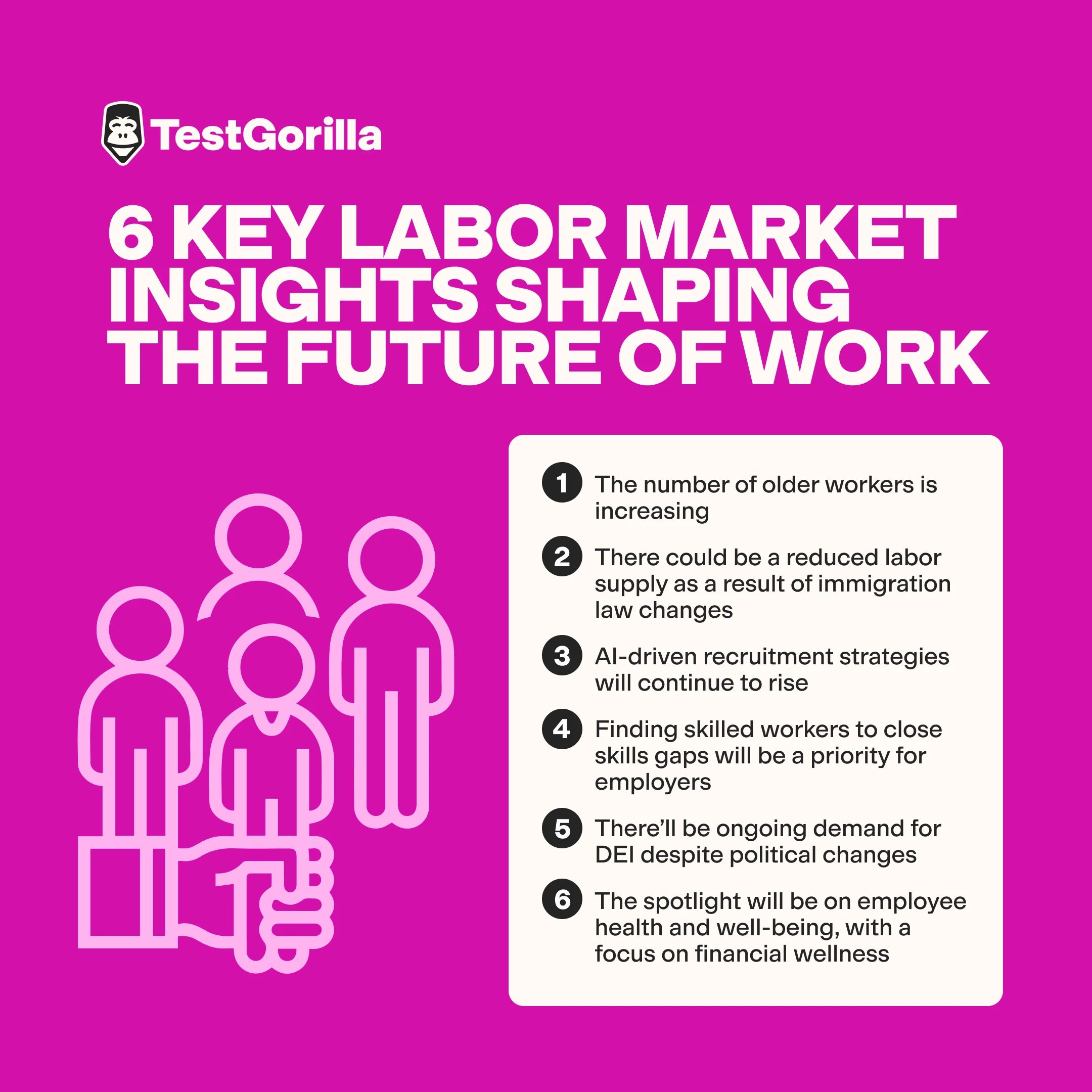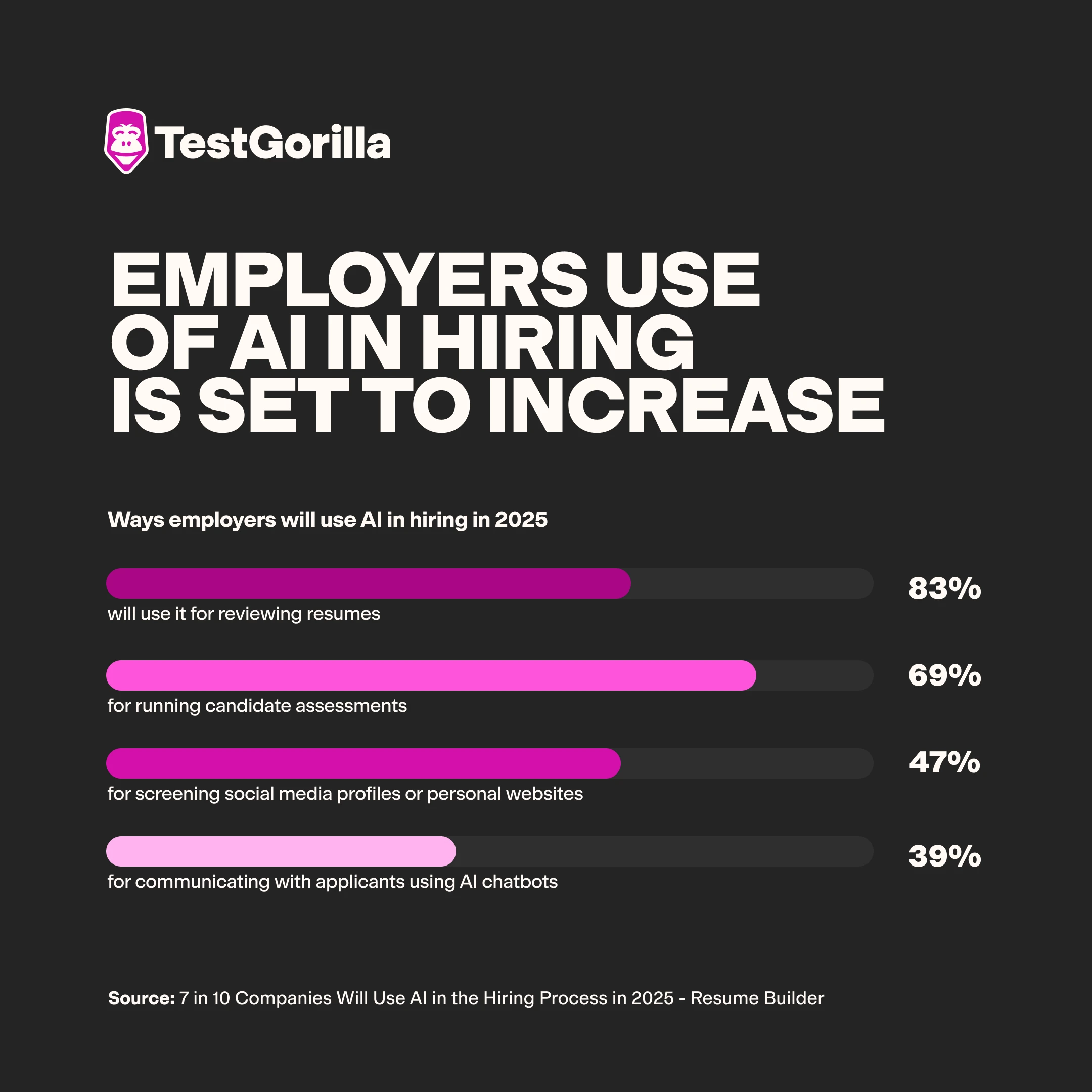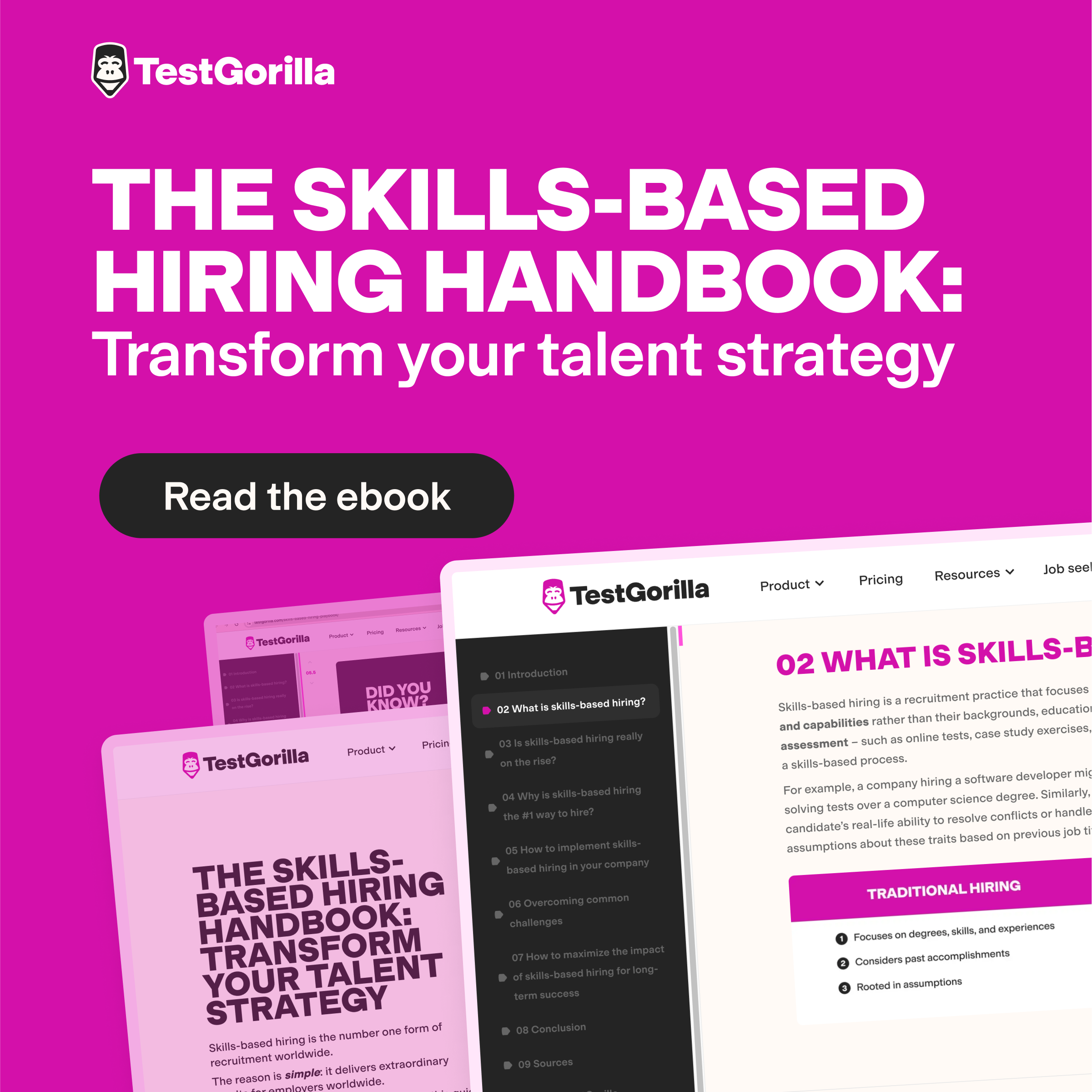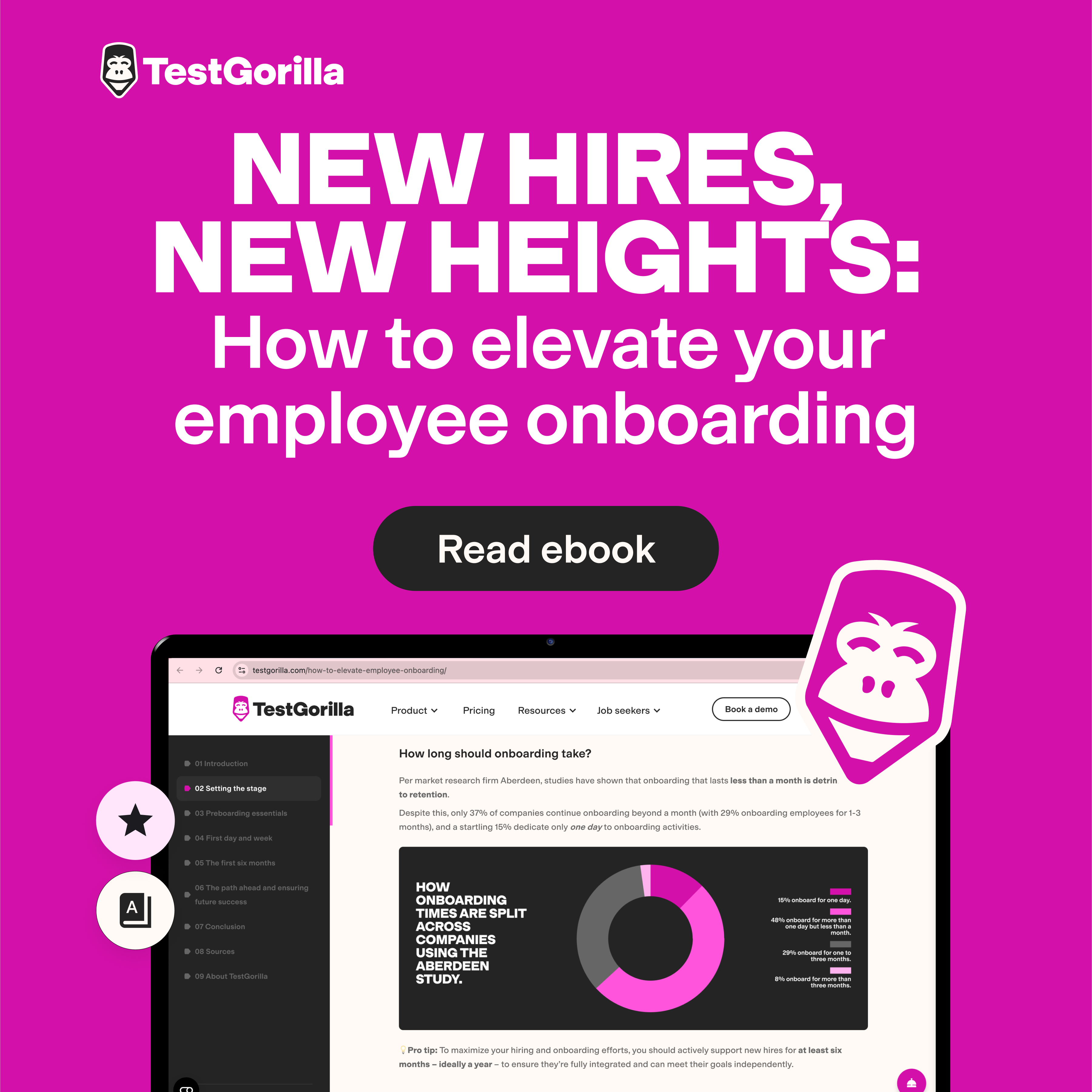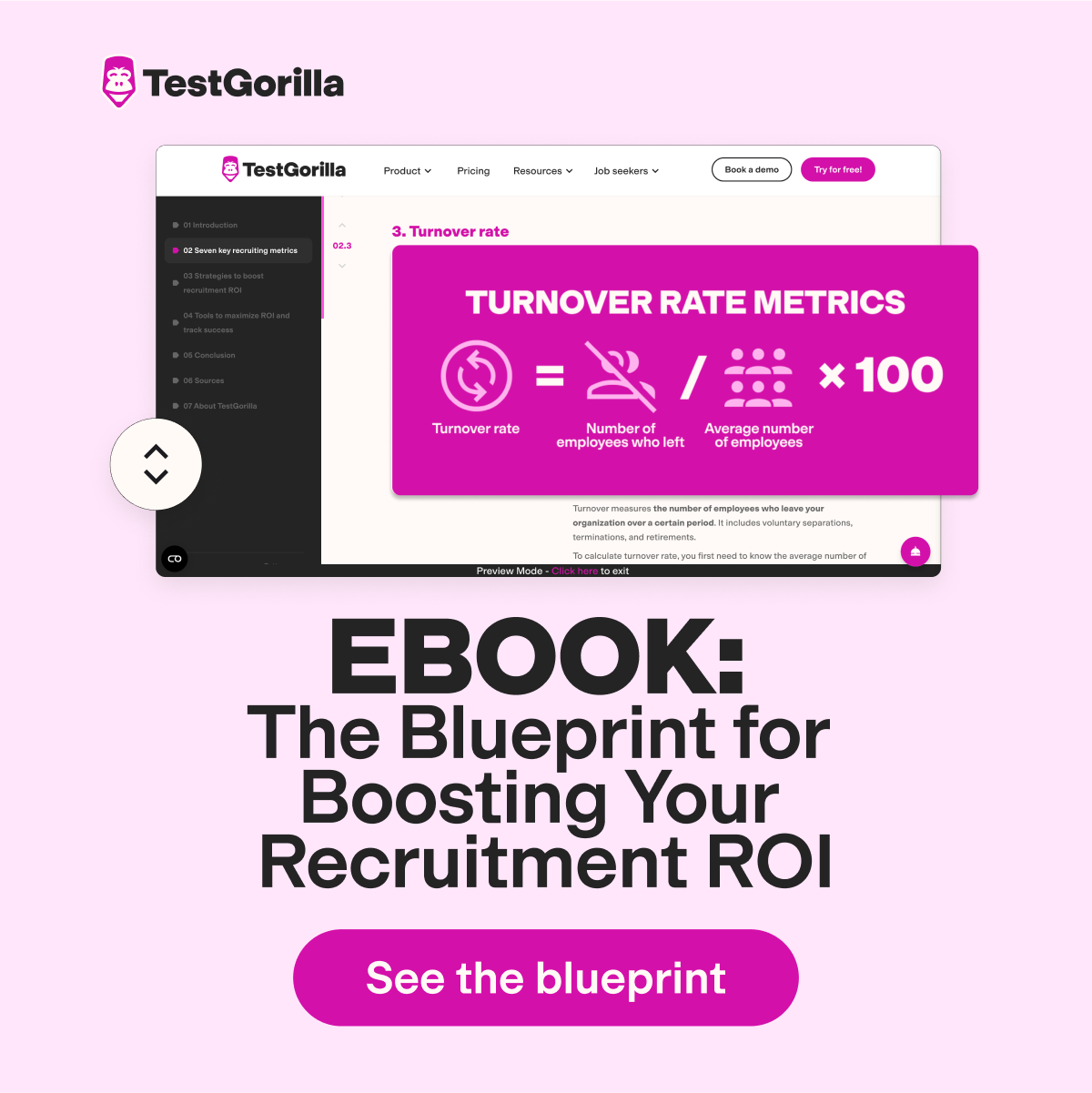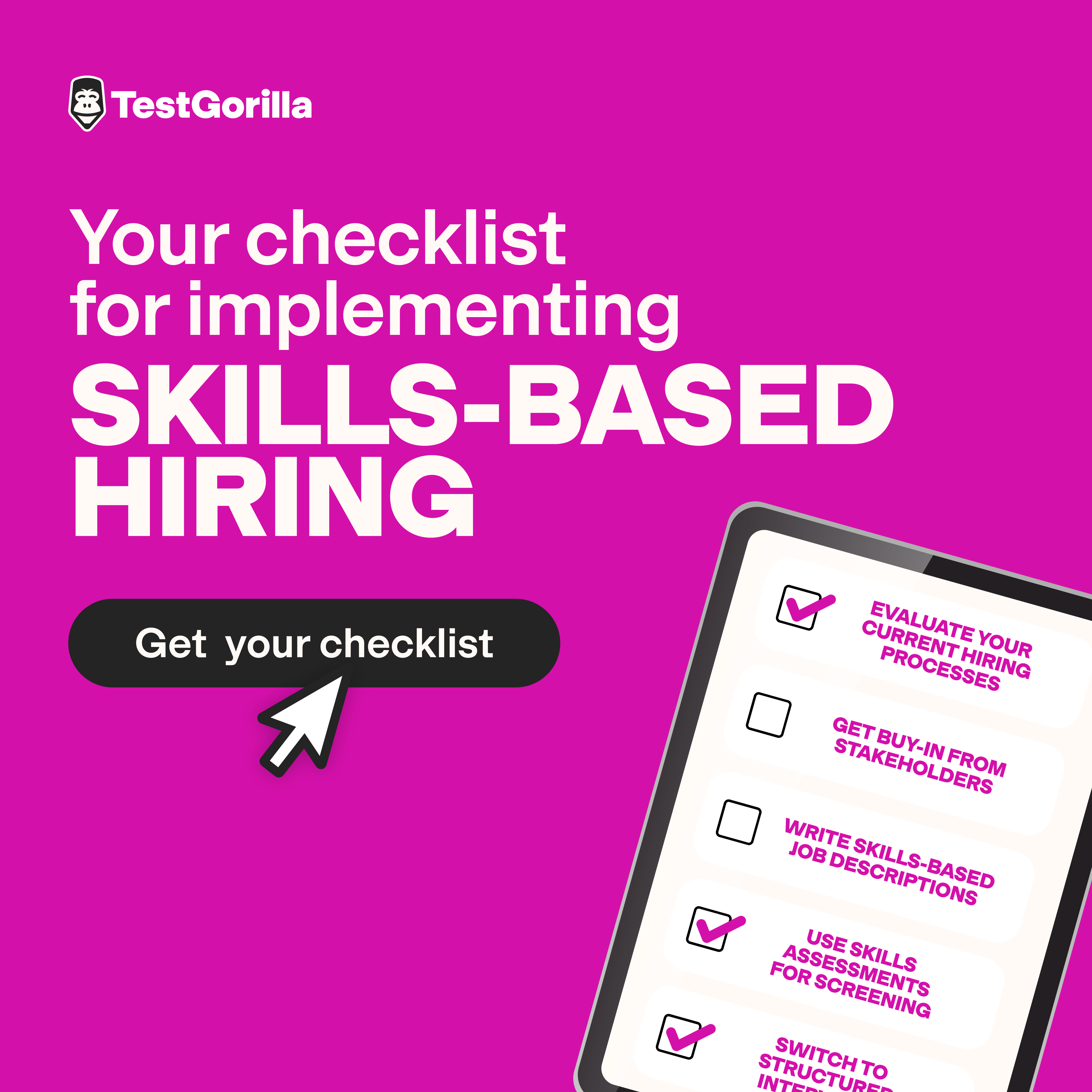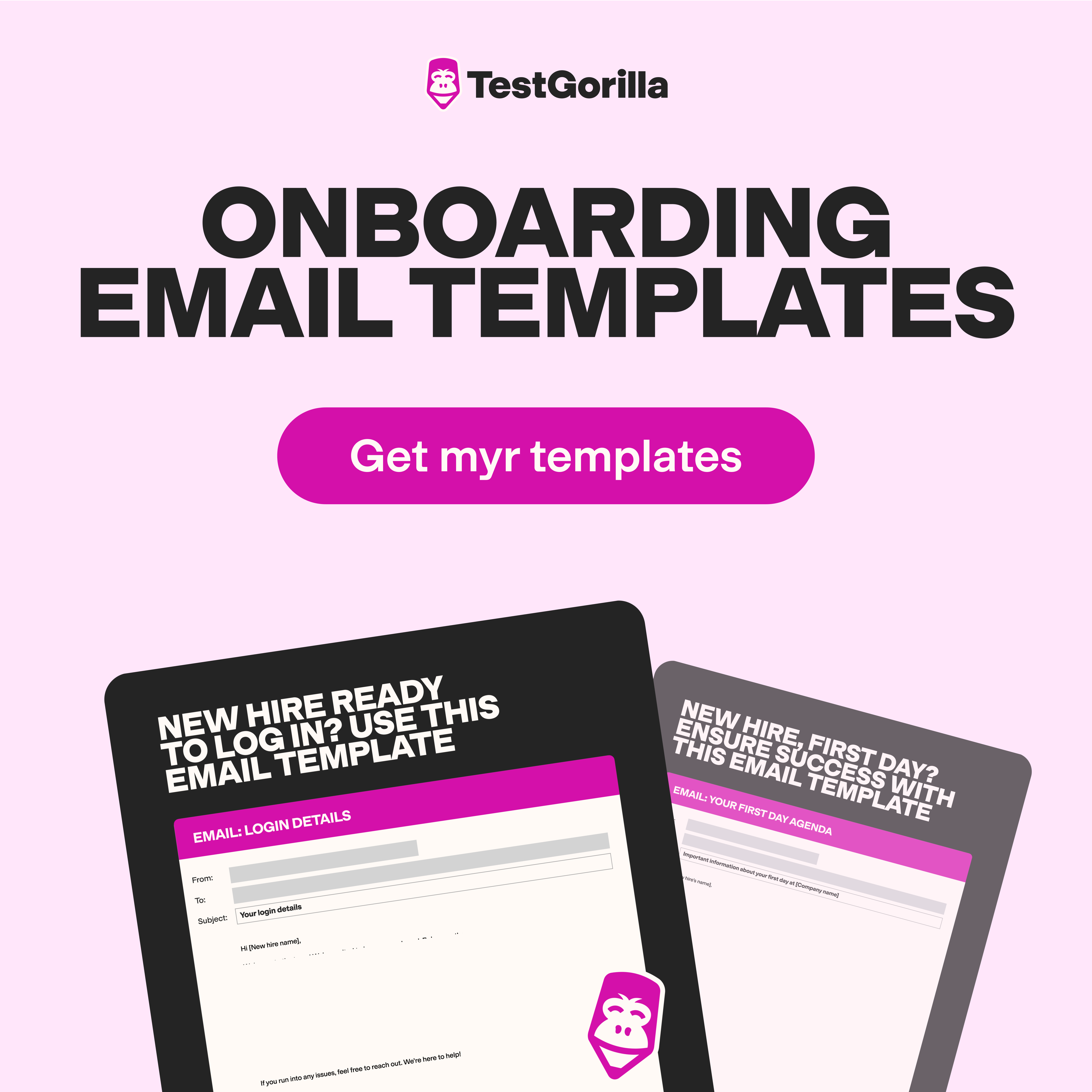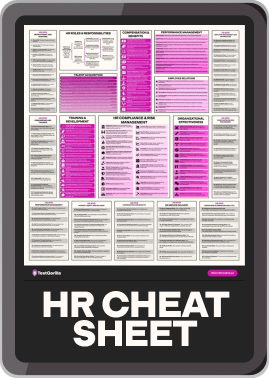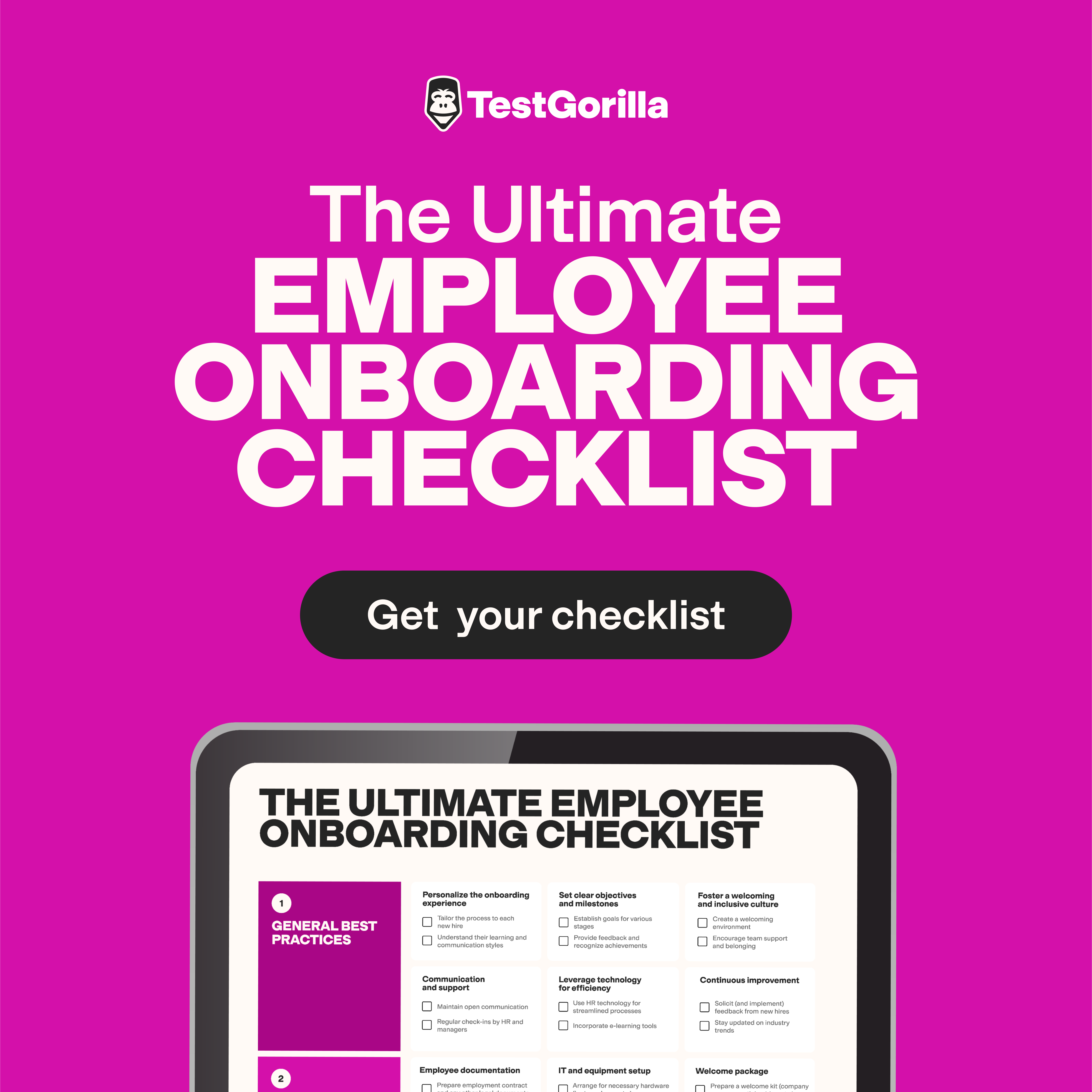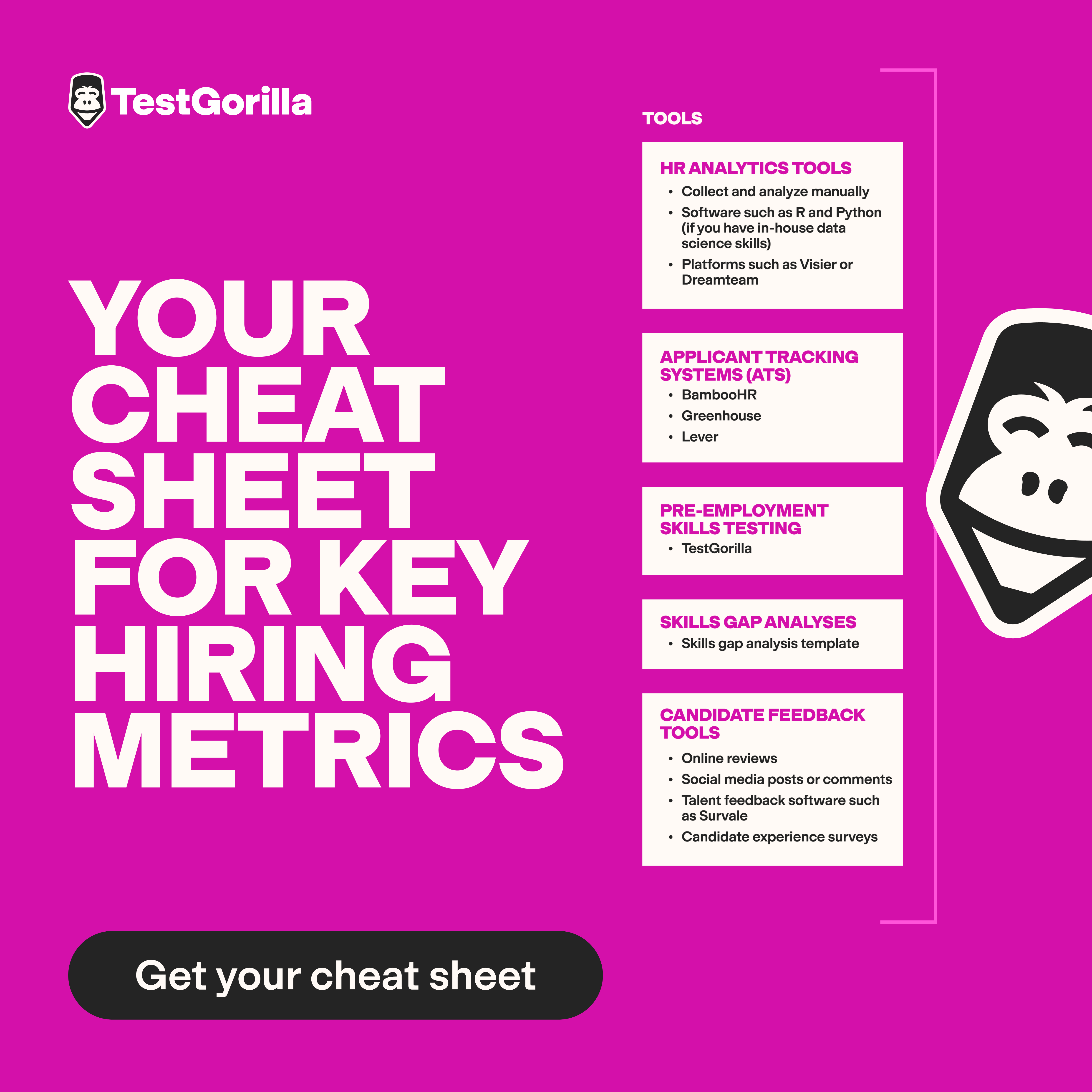With a new US president, the continued rise of AI, and evolving employee expectations, the future is shaping up to be somewhat of a rollercoaster for the labor market. While challenges lie ahead, there are also exciting opportunities for growth.
Below, we look at six labor market trends to expect in the future – sharing our insights and practical advice on how to navigate the future of work and help your business and its workforce thrive.
Table of contents
- 1. The number of older workers is increasing
- 2. There could be a reduced labor supply as a result of immigration law changes
- 3. AI-driven recruitment strategies will continue to rise
- 4. Finding skilled workers to close skills gaps will be a priority for employers
- 5. There’ll be ongoing demand for DEI despite political changes
- 6. The spotlight will be on employee health and well-being, with a focus on financial wellness
- Future proof your business for the years to come
1. The number of older workers is increasing
The general population is living longer and, therefore, working longer. This is reflected in rising retirement ages worldwide. Several countries – including the US, UK, France, and Australia – have increased the retirement age to 67 or will soon do so.
This means the labor market is getting older. According to the Pew Research Center, 11% of adults aged 65 and over were working in 1987. As of 2023, this figure is 18%. The US Bureau of Labor Statistics predicts that 21% of older adults will be working or looking for work by 2032.
Pew attributes this to several factors:
More Americans now have higher levels of education than previous generations.
Older Americans are in better health than generations before them, making it possible for them to work longer.
The increase in less physically demanding jobs means more roles are available to older workers.
Changes to retirement plans and broader policy have disincentivized early retirement.
Increasing cost-of-living and financial pressures also contribute to this trend. Mercer's 2024 Global Talent Trends report – which surveyed over 12,200 executives, HR leaders, employees, and investors – found that only 9% of Gen Z workers intend to stop working completely once they hit retirement age, compared with 21% of Baby Boomers. The main reason? Financial necessity.
While older workers continue to be a minority in the workforce, their numbers will increase, and employers must prepare for this. These workers have unique concerns, which are important to address when attracting and retaining them.
For example, Mercer’s Global Talent Trends report found that older workers are the group that’s least likely “to feel energized, trust their company, and feel valued at work.” The report also found that 76% of employees report seeing age-based discrimination in the workplace.
What can employers do?
Start by considering the unique benefits your older workers want, such as flexible work arrangements or grandparent leave.
Skills development is also another important factor to consider. Some employers write off older workers as fixed in their ways and “untrainable,” while others assume they already know everything they need to know. This is a mistake.
Employers should prioritize skills development for all workers, including older ones. You can do this by investing in their professional development, including them in skills gap analyses, and seeking their feedback on the professional development opportunities they’d like.
Given the prevalence of age-based discrimination, intentional inclusion – a proactive and considered approach to inclusion in the workplace – is another key strategy for ensuring older workers feel supported. Make sure your policies and practices align with this strategy by actively promoting respect and opportunities for employees of all ages.
2. There could be a reduced labor supply as a result of immigration law changes
The Trump administration has foreshadowed sweeping changes to immigration law and policy that could significantly impact labor supply. President Trump signaled his commitment to these election promises by signing a raft of executive orders immediately after his inauguration on January 20, including an attempt to end birthright citizenship.
One of his strategies involves mass deportations of undocumented migrants, signaling a likely increase in enforcement and worksite raids. Commentators have noted that this policy could result in significant labor shortages in specific industries, including construction, agriculture, and hospitality.
Regarding work visas, there may be increased scrutiny of visa applications – and the work rights currently attached to certain visas could change.
We saw this play out during the first Trump administration, when greater scrutiny of H-1B visas increased the number of applications that were rejected. (H-1B visas are intended for highly educated foreign workers in specialty occupations requiring expertise.) How this will look this time round remains to be seen, as President Trump has also recently expressed support for the H-1B program.
Further immigration restrictions could limit candidate pools for employers who hire highly skilled workers from overseas. This would especially impact industries that rely on this type of labor, such as the tech industry.
What can employers do?
In the coming years, you must be prepared to adapt to any changes in the law and subsequent effects on the labor market. Seek advice from an employment lawyer and stay current with any developments in this space.
If these changes go through, they’ll affect the make-up of the labor market, likely by reducing certain candidate pools. To safeguard your talent pipeline, adopting a skills-based approach to hiring is essential. By prioritizing skills over qualifications or previous job titles, you can identify alternative candidate sources, such as STARs (those skilled through alternative routes) and applicants with transferable skills who can easily switch industries.
Businesses in industries reliant on migrant workers (like construction, agriculture, and hospitality) can aim their recruitment efforts at underutilized local talent pools – like young workers looking for their first jobs or retired or long-term unemployed individuals looking to rejoin the workforce. Skills-based hiring can, again, help identify candidates with the skills necessary for certain roles.
The best insights on HR and recruitment, delivered to your inbox.
Biweekly updates. No spam. Unsubscribe any time.
3. AI-driven recruitment strategies will continue to rise
In 2025 and beyond, the use of AI in hiring is set to increase. In October 2024, Resume Builder spoke with 948 business leaders. It found that 51% of organizations already use AI in their hiring practices, and by the end of 2025, this will increase to 68%.
According to Resume Builder’s findings, the ways employers will use AI in hiring in 2025 include the following:
83% will use it for reviewing resumes
69% for running candidate assessments
47% for screening social media profiles or personal websites
39% for communicating with applicants using AI chatbots
This is part of a broader trend toward organizations adopting AI. According to the World Economic Forum’s 2025 Future of Jobs report, which surveyed more than 1,000 global employers, 86% expect AI and information processing to be among the most transformative trends for businesses in 2025.
What can employers do?
We advocate for taking a human-centric approach to using AI in recruitment. This means adopting it in a way that supports the work of your hiring team rather than replacing their decision-making entirely.
There are inherent risks with using AI in any context, including recruitment. For example, while AI is often sold as the solution for removing unconscious bias from hiring, it can instead worsen bias. AI contains its own biases. For example, AI that’s trained on unrepresentative data samples or that inherits programmers’ bias can discriminate in hiring. For instance, University of Washington research found that AI favored white-associated names in resumes.
When deciding how to use AI in your hiring process, consider how it can best complement your hiring team’s work while ensuring human oversight. For example, AI is an excellent tool for streamlining repetitive, time-consuming tasks like scheduling interviews or updating candidates. But you shouldn’t let AI automatically reject candidates, as this could result in candidates being rejected based on AI biases or other flawed reasoning.
You must also be transparent about your use of AI. Workers demand honesty from organizations now more than ever. So, you should always inform candidates or employees how you use AI in any HR-related process. In some places, this is even a legal requirement – for instance, in Illinois, employers must tell employees when they use AI to analyze recorded video interviews.
4. Finding skilled workers to close skills gaps will be a priority for employers
Finding a way to fill emerging skills gaps is going to be on every employer’s mind this year, especially when it comes to technological skills. According to the World Economic Forum’s Future of Jobs report, the top five fastest-growing skills by 2030 will be:
AI and big data
Networks and cybersecurity
Technological literacy
Creative thinking
Resilience, flexibility, and agility
However, employers are struggling to keep up with the growing distance between the skills they need and the skills workers offer. Sixty-three percent say skills gaps are a major challenge to business transformation. The reality? There aren’t enough workers with these skills to meet market demands.
There are two ways you can address skills gaps – either by hiring new people or upskilling your existing workforce. According to the World Economic Forum, there’ll be a strong focus on the latter. Eighty-five percent of employers intend to prioritize upskilling employees, while 70% intend to hire new staff.
What can employers do?
First, you must determine which skills gaps exist in your organization.
Conducting a skills gap analysis is a great way to get a detailed understanding of your employees’ existing skills and the skills your organization needs now and in the future.
Developing a skills ontology that maps out the skills in your organization is an important part of this process. This can help you organize, classify, and better understand these skills – including the relationships between them (including skills hierarchies). This can in turn help you update or create better job descriptions – while identifying those skills that can transfer across roles.
With this information, you can identify professional development opportunities and be more strategic in your hiring.
Where you’re hiring new people or upskilling (and perhaps redeploying) current staff, we recommend taking a skills-based approach to recruitment and workforce management, including strategies such as:
Removing degree requirements from role descriptions when they’re not critical
Centering role descriptions around the skills candidates need to succeed in the role
Using skills tests, like TestGorilla’s, to assess candidates' hard and soft skills in an unbiased way
By prioritizing skills when hiring, you can also identify internal and external candidates with transferable and soft skills that indicate a willingness to learn and adapt to a new role.
The best part of taking a skills-based approach? The benefits go far beyond addressing skills gaps.
We spoke to 1,019 employers and 1,100 employees in nine countries – including the US, Australia, and Germany – for our 2024 State of Skills-Based Hiring report. According to employers, the benefits of a skills-first strategy include the following:
90% of employers said it reduced the chances of a mis-hire.
91% reported improved retention.
90% saw improved diversity as a result.
5. There’ll be ongoing demand for DEI despite political changes
We're also seeing significant changes in the DEI space. Unfortunately, the first few weeks of this year suggest there’ll be a strong political and legal shift away from DEI commitments.
On his first day back in office, President Trump signed an executive order ending all DEI programs and activities in federal departments and agencies. This executive order also tasks agency heads with encouraging the public sector to follow. Immediately following this, the President ordered anyone in a federal DEI role to be put on paid leave, with layoffs anticipated.
With change on the horizon in the lead-up to the inauguration, several major employers, including Meta, confirmed they’re ditching their DEI initiatives.
Despite this, data shows that DEI continues to matter to candidates and employees in the coming years.
According to a survey of 1,345 employees and leaders by US think tank The Conference Board, 58% feel their organization’s DEI initiatives are appropriate, and 21% even say their employer's DEI approach could be better. The survey also highlighted an important link between DEI initiatives and key performance metrics, with 71% saying DEI strategies were key to improving their sense of belonging in the workplace, and 59% confirming it improved collaboration and retention.
The shifting political and legal landscape around DEI understandably rattles employers. According to The Conference Board’s survey, 63% of executives describe the political climate for DEI as very or extremely challenging. However, business leaders will continue to deliver on their DEI commitments despite these concerns. Only 3% of executives indicated plans to scale back internal DEI communications over the next year.
What can employers do?
At TestGorilla, we strongly believe in the benefits of DEI for workers, employers, and consumers. Aside from promoting fairness and human rights, DEI has a strong business case. A diverse workforce that reflects the community an organization serves offers tons of positives – from improved creativity, innovation, and decision-making to increased engagement and retention.
On the flip side, there could be dire consequences to scaling back DEI, like consumer backlash and lowered employee morale.
You should continue to honor your commitments to DEI in the workplace, although precisely what this looks like in 2025 remains to be seen. Importantly, you must stay on top of any developments on this topic in the coming months. There could be extensive legal changes affecting how the private sector can carry out DEI activities, so watch this space to ensure you stay compliant.
6. The spotlight will be on employee health and well-being, with a focus on financial wellness
According to Mercer’s 2024 Global Talent Trends report, investing in benefits to support employees' physical and mental health is the second top priority for HR leaders worldwide. In the coming years, we expect an emphasis on the impact of stress and supporting workers’ mental health, including addressing issues like burnout.
Recent research by Boston Consulting Group – involving 11,000 workers in 8 countries – found that almost half (48%) of workers are currently experiencing burnout. Burnout occurs due to a combination of work and non-work-related factors, including the pressure to perform, long work hours, cost-of-living pressures, and the need to juggle work commitments with family life and caring responsibilities.
(On a related note, the same research found that inclusion is key to addressing this, with burnout rates halving when employees feel included. This further highlights why DEI continues to be important in 2025!)
The benefits of investing in employee health and well-being are evident for employees. However, this approach is also advantageous to employers. Healthier employees are more satisfied, productive, and likely to stay with an organization. Prioritizing this in 2025 and beyond can help reduce absenteeism and turnover more broadly.
Many employers are starting to recognize this: According to the World Economic Forum’s 2025 Future of Jobs report, 64% of employers say that supporting the health and well-being of employees will be a central strategy for attracting talent.
What can employers do?
A good starting point is to review your benefits and employee assistance or wellness programs to ensure they’re addressing your employee’s wants and needs. Employee pulse surveys are a great way to get immediate feedback about how you can best support them.
Our tip for designing benefits and programs to support employee well-being in 2025 is to consider financial wellness. There’s an increasing demand for this in light of the rising costs of living and the heightened number of older workers considering supporting themselves during retirement. Financial Finesse founder and CEO Liz Davidson, speaking to Harvard Business Review last year, said, “Employee financial stress is at the greatest level it’s been since the Great Recession.”
Developing a financial wellness program could include:
Delivering general financial education workshops in the workplace or online
Giving employees access to financial counselors for tailored advice and support
Signing employees up for software that helps them develop individual financial plans and track their progress
Providing emergency savings programs, perhaps with matched contributions
Don’t get left behind – the number of employers that offer financial wellness programs is steadily increasing. According to the analysis of a panel of experts organized by insurance company Transamerica, 47% of employers will offer these programs by December 2026.
Future proof your business for the years to come
The future of the labor market will likely deliver both challenges and opportunities for employers.
We’ll see demographic changes in the labor market, including an increasing number of older workers and potentially reduced candidate pools. Incorporating AI into hiring practices and addressing skills gaps will be priorities for employers, while candidates and employees want to see organizations supporting DEI and their individual wellbeing.
One key way you can prepare your business to navigate many of these changes is to adopt a skills-based approach to both hiring and workforce management. This approach will help you identify and attract diverse talent while ensuring your workforce stays flexible and adaptable to accommodate the changes, challenges, and opportunities the coming years will bring.
You've scrolled this far
Why not try TestGorilla for free, and see what happens when you put skills first.


